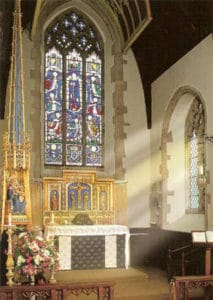Walsingham, England: Our Lady of Walshingham Shrine
About the Shrine of Our Lady of Walsingham:
You could say this is not one shrine but two–one Roman Catholic and one Protestant (Anglican). The history dates back to 1061 AD when, according to tradition, a noble woman, Lady Richeldis, was spiritually transported by the Our Lady to ancient Nazareth to see the home where the Archangel Gabriel had greeted Mary with the greeting “Hail, full of grace”.
Lady Richeldis was directed to take measurements of the house so that she could build one like it in Walsingham and thereby give honor to the Annunciation. Our Lady of Walsingham was the most popular Christian devotion in Northern Europe during the Middle Ages, when England was known as “Mary’s Dowry.”
Pilgrims were accustomed to stop at a chapel about a mile away from the site and remove their shoes so that they might walk the final mile of their pilgrimage barefoot. This chapel, therefore, became known as the “Slipper Chapel”. to make the mile-long trek on bare feet from the slipper chapel to the Walsingham Shrine. The shrine was destroyed by King Henry VIII in the 16th Century. All that remains is the Slipper Chapel.
Once the Protestant Reformation took hold and King Henry enacted the Act of Supremacy, the statue of Our Lady of Walsingham was taken to London and burnt in the presence of Cromwell himself. After this, devotion to the shrine waned and the site fell into ruin. Today nothing remains of the original shrine except a marker denoting where it used to stand.

However, the Slipper Chapel did survive and was purchased by a woman in 1896 (the Catholic Emancipation was passed in 1829) and so Masses could now be held in the chapel. In 1934 a pilgrimage led by the Bishops of England and Wales drew 10,000 pilgrims and at the time the Shrine was declared to be the National Shrine of Our Lady in England.
e
The statue of Our Lady of Walsingham, re-created in the early 1900’s and placed in the slipper chapel, played a significant role during the visit of Pope John Paul II to England in 1982. The statue was taken to Wembley Stadium, site of the Papal Mass, and paraded around the stadium in a procession led by both the director of the Roman Catholic shrine and the administrator of the Anglican shrine. The Holy Father then had the statue placed on the altar during Mass.
The shrine – specifically the Slipper Chapel, the Chapel of Reconciliation and the Domain – were granted Minor Basilica status as of December, 2015.
The Shrine draws an estimated 100,000 pilgrims each year, both groups and individuals.
The Feast of Our Lady of Walsingham is celebrated by Roman Catholics on September 24 and by Anglicans on October 15.
Traveling to Our Lady of Walsingham:
The closest rail stations are either in are Norwich or King’s Lynn, about 30 miles away.
Address (office): 2 Common Place, Walsingham, Norfolk NR22 6EE, U.K.
GPS coordinates: 52° 53′ 40.2036” N, 0° 52′ 26.1192” E
Tel: +44 (01) 328 820255 Fax: +44 (01) 328 824206
e-mail: rcnationalshrine@walsingham.org.uk
Click here for the official website of the Roman Catholic Shrine of Our Lady of Walsingham.
An interesting note: you will find Our Lady of Walsingham parishes in many countries that are Anglican Rite parishes. That is, they are Anglicans who have converted to Roman Catholicism, but use the former Anglican rite. This is known as the Personal Ordinariate of the Chair of Saint Peter…for more details click here.
There are several in the U.S.A.
Click here for the National Shrine of Our Lady of Walsingham in Willamsburg, Virginia.
Also, click here for the Cathedral of Our Lady of Walsingham in Houston, Texas (the principal Anglican Rite Cathedral in the U.S.).

